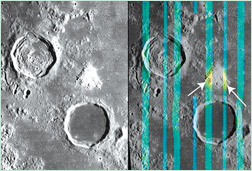|
New type of moon volcano discovered :
Silica-rich rocks reveal unusual lunar eruptions
Rachel Kaufman
If the moon were actually made of cheese, there'd be a new flavor of
dairy for humans to sample. Data from NASA's Lunar Reconnaissance
Orbiter (LRO) have revealed a new type of rock on the lunar surface -
which scientists say was spat up by a style of volcano never before seen
on the moon.
|

A 1967 Lunar Orbiter IV picture of the arrowhead-shaped
Hansteen Alpha region (left) and the same picture with new
LRO data superimposed, showing silica-rich areas in red and
yellow. Diagram courtesy NASA/Goddard/UCLA/Stony Brook |
Until now, scientists had believed the moon was made of two basic
types of rock: dark basalt and light, calcium-rich feldspar. Both would
have come from volcanoes spewing relatively runny basaltic lava.
But the new volcano type oozed thicker lava rich in silica over a
light, arrowhead-shaped patch of the moon roughly 18 miles (30
kilometers) across, called Hansteen Alpha, the scientists say.
New moon material already on earth
The new type of moon volcano is now extinct - the last time it oozed
any lava was two billion years ago at best, assistant professor of
geosciences at Stony Brook University and co-author of a new paper
Timothy Glotch said describing the find.
Scientists found the volcano using LRO's Diviner instrument, which
looks at light being reflected from the moon's surface in mid- to
far-infrared wavelengths.
Different minerals will reflect unique signatures of light in these
wavelengths, allowing the team to map the moon's surface composition.
But the technique reveals only mineral abundance - identifying the exact
types of rocks present will require further research.
On Earth, volcanoes similar to the one that birthed Hansteen Alpha
create silica-based minerals such as quartz, potassium feldspar, and
granite - any of which could be candidates for the new moon rock.
The LRO scientists think pockets of the newfound silica-based rock
must have been created as basaltic magma deep in the moon melted some of
the silica-containing deep crust.
Some of this newly minted material rose to the surface as lava, while
some of it cooled deeper underground.
National Geographic News |



